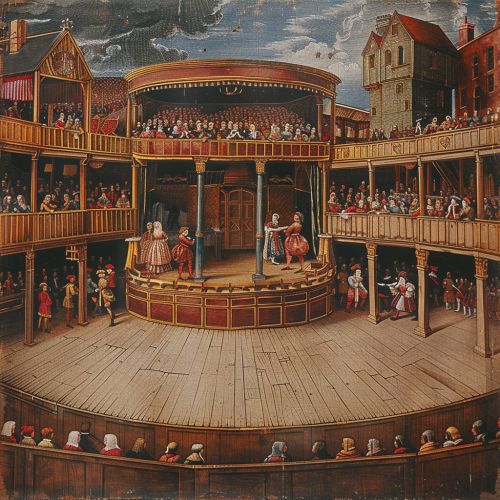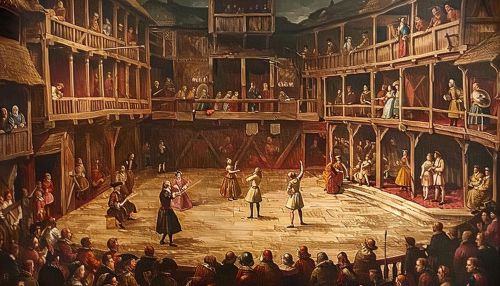The Groundlings: Difference between revisions
(Created page with "== Introduction == The Groundlings were a significant part of the audience in the Elizabethan theatre, particularly known for their presence in the Globe Theatre and other similar venues. These individuals, often from the lower social classes, played a crucial role in the dynamics of theatrical performances during the late 16th and early 17th centuries. This article delves into the historical context, social implications, and cultural significance of th...") |
No edit summary |
||
| Line 33: | Line 33: | ||
The design of Elizabethan theatres, with their open roofs and thrust stages, was conducive to the Groundlings' participation. The proximity of the pit to the stage allowed for a more intimate and immersive experience. The actors had to project their voices and use exaggerated gestures to ensure that even those at the back of the pit could follow the performance. | The design of Elizabethan theatres, with their open roofs and thrust stages, was conducive to the Groundlings' participation. The proximity of the pit to the stage allowed for a more intimate and immersive experience. The actors had to project their voices and use exaggerated gestures to ensure that even those at the back of the pit could follow the performance. | ||
[[Image:Detail-92557.jpg|thumb|center|Depiction of an Elizabethan theatre with a crowded pit and actors performing on stage.|class=only_on_mobile]] | |||
[[Image:Detail-92558.jpg|thumb|center|Depiction of an Elizabethan theatre with a crowded pit and actors performing on stage.|class=only_on_desktop]] | |||
=== Performance Techniques === | === Performance Techniques === | ||
Latest revision as of 19:13, 17 June 2024
Introduction
The Groundlings were a significant part of the audience in the Elizabethan theatre, particularly known for their presence in the Globe Theatre and other similar venues. These individuals, often from the lower social classes, played a crucial role in the dynamics of theatrical performances during the late 16th and early 17th centuries. This article delves into the historical context, social implications, and cultural significance of the Groundlings, providing a comprehensive understanding of their influence on Elizabethan drama.
Historical Context
Elizabethan Theatre
Elizabethan theatre refers to the period of theatrical history during the reign of Queen Elizabeth I (1558-1603). This era witnessed the flourishing of English drama, with playwrights such as William Shakespeare, Christopher Marlowe, and Ben Jonson producing works that have become timeless classics. Theatres like the Globe, the Rose, and the Swan were central to this cultural explosion.
The Globe Theatre
The Globe Theatre, constructed in 1599 by Shakespeare's playing company, the Lord Chamberlain's Men, is perhaps the most famous venue associated with the Groundlings. The theatre was an open-air amphitheater with a capacity of around 3,000 spectators. It featured a thrust stage surrounded by three tiers of seating and a standing area known as the "pit" or "yard," where the Groundlings would gather.
The Groundlings
Definition and Origin
The term "Groundlings" refers to the audience members who stood in the pit of the theatre. They paid a mere penny for admission, which was significantly cheaper than the seated areas. The name "Groundlings" is derived from their position on the ground level, directly in front of the stage.
Demographics
Groundlings were typically from the lower social strata, including apprentices, laborers, and tradespeople. Their economic status often dictated their mode of participation in the theatre, as they could not afford the more expensive seats in the galleries.
Behavior and Interaction
The Groundlings were known for their boisterous and interactive behavior during performances. They would often shout, cheer, boo, and even throw objects at the actors if displeased. This interaction created a dynamic and sometimes unpredictable atmosphere, influencing the way plays were performed and received.
Cultural Significance
Influence on Playwriting
Playwrights of the Elizabethan era were acutely aware of the Groundlings' presence and tailored their works to appeal to this diverse audience. The inclusion of bawdy humor, physical comedy, and sensational scenes can be attributed to the need to engage the Groundlings. Shakespeare, for instance, often incorporated puns, slapstick, and dramatic action to cater to their tastes.
Social Commentary
The presence of the Groundlings also allowed for a unique form of social commentary. Playwrights could address issues of class, politics, and morality in a manner that resonated with the common people. The Groundlings' reactions served as a barometer for the societal impact of these themes.
Economic Impact
The affordability of standing in the pit made theatre accessible to a broader segment of the population, thereby increasing the overall audience size and revenue for theatre companies. This economic model helped sustain the vibrant theatrical culture of the Elizabethan era.
Theatrical Experience
Stage Design and Acoustics
The design of Elizabethan theatres, with their open roofs and thrust stages, was conducive to the Groundlings' participation. The proximity of the pit to the stage allowed for a more intimate and immersive experience. The actors had to project their voices and use exaggerated gestures to ensure that even those at the back of the pit could follow the performance.


Performance Techniques
Actors developed specific techniques to engage the Groundlings, such as direct address and asides. These methods created a sense of inclusion and involvement, making the audience an integral part of the performance. The Groundlings' reactions could also influence the pacing and delivery of the play.
Legacy
Modern Interpretations
The concept of the Groundlings has persisted into modern times, with contemporary theatres often incorporating standing areas to recreate the dynamic atmosphere of Elizabethan performances. The Globe Theatre in London, reconstructed in 1997, includes a pit for standing spectators, paying homage to the original Groundlings.
Cultural References
The Groundlings have been referenced in various literary and artistic works, symbolizing the democratization of theatre and the enduring appeal of live performance. Their legacy is a testament to the inclusive and interactive nature of Elizabethan drama.
Conclusion
The Groundlings were more than just passive spectators; they were active participants who shaped the theatrical experience of the Elizabethan era. Their presence influenced playwriting, performance techniques, and the overall culture of the theatre. Understanding the role of the Groundlings provides valuable insights into the social and cultural dynamics of the time, highlighting the enduring impact of this unique audience on the history of drama.
